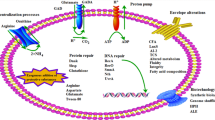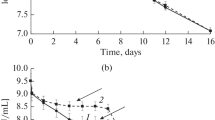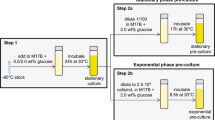Abstract
The adaptation of lactic acid bacteria (LAB) to unfavorable growth conditions, e.g., depletion of nutrient sources, overthreshold cell density of a population, or antibiotic impact, was shown to include: (1) formation of cyst-like dormant cells (CDC) providing for survival and species preservation and (2) realization of intra-population phenotypic variability, which is demonstrated by development of non-dominant colonies on plates inoculated with CDC suspensions. In Lactobacillus plantarum, the dormant cells, which retained viability and heat resistance for a long time, were formed in 10- and 20-fold concentrated suspensions of the stationary phase cells. In 4-month cell suspensions, two types of cells were present, CDC and L-forms. The CDC of Lactococcus lactis were formed in (1) post-stationary cultures grown under glucose limitation and (2) in stationary phase cultures resuspended in starvation medium (without glucose). Populations of CDC stored for different periods of time varied in the ability for phase variation; as a result, both variants exhibited a shift of the population’s CDC spectrum to the transition of the dominant S-colony type to the R-type up to complete substitution (by day 25). In Lactobacillus acidophilus AT-41, CDC appeared in (1) post-stationary cultures grown on a nitrogen-limited medium; (2) autolyzing cultures treated with ampicillin or erythromycin; and (3) concentrated (10- and 20-fold) suspensions of stationary-phase cells. At plating of L. acidophilus CDC, the substitution of the S-type for the dominant R-type in variants (1) (day 30), (2) (100 μg/ml ampicillin, day 10), and (3) (day 25) was 68.6%, 30.1%, and 61.2%, respectively. The S-variant of L. acidophilus was used for development of a novel lactofermented product based on vegetable (beet) juice fermentation, which sustained high titer of viable cells (2 × 106 cells/ml).
Similar content being viewed by others
References
Ishibashi, N. and Yamazaki, S., Probiotics and Safety, Am. J. Clin. Nutr., 2001, vol. 73, pp. 465–470.
Hartke, A., Bouche, S., Gansel, X., Boutibonnes, P., and Auffray, Y., Starvation-Induced Stress Resistance in Lactococcus lactis subsp. lactis IL1403, Appl. Environ. Microbiol., 1994, vol. 60, no. 9, pp. 3474–3478.
Chou, L.S. and Weimer, B., Isolation and Characterization of Acid- and Bile-Tolerant Isolates from Strains of Lactobacillus acidophilus, J. Dairy Sci., 1999, vol. 82, no. 1, pp. 23–31.
Kunji, E.R.S., Ubbink, T., Matin, A., Poolman, B., and Konings,.N., Phisiological Response of Lactococcus lactis ML3 to Alternating Conditions of Growth and Starvation, Arch. Microbiol., 1993, vol. 159, pp. 372–379.
Ganina, V.I., Probiotiki. Naznachenie, svoistva i osnovy biotekhnologii: Monografiya (Probiotics: Application, Properties, and Fundamentals of Biotechnology), Moscow: MGUPB, 2001.
Douglas, L.C. and Sanders, M.E., Probiotics Prebiotics in Dietetics Practice, J. Am. Diet. Assoc., 2008, vol. 108, no. 3, pp. 510–521.
Macfarlane, G.T., Steed, H., and Macfarlane, S., Bacterial Metabolism and Health-Related Effects of Galacto-Oligosaccharides and Other Prebiotics, Appl. Environ. Microbiol., 2008, vol. 104, no. 2, pp. 305–344.
Adams, M.R. and Marteau, P., On the Safety of Lactic Acid Bacteria from Food, Int. J. Food. Microbiol., 1995, vol. 27, pp. 263–267.
Kim, W.S., Park, J.H., Ren, J., Su, P., and Dunn, N.W., Survival Response and Rearrangement of Plasmid DNA of Lactococcus lactis during Long-Term Starvation, Appl. Environ. Microbiol., 2001, vol. 67, no. 10, pp. 4594–4602.
Bukharin, O.V., Gintsburg, A.L., Romanova, Yu.M., and El’-Registan, G.I., Mekhanizmy vyzhivaniya bakterii (Mechanisms of Bacterial Survival), Moscow: Meditsina, 2005.
Thorne, S.H. and Williams, H.D., Adaptation to Nutrient Starvation in Rhizobium leguminosarum bv. phaseoli: Analysis of Survival, Stress Resistance, and Changes in Macromolecular Synthesis During Entry to and Exit from Stationary Phase, J. Bacteriol., 1997, vol. 179, no. 22, pp. 6894–6901.
Kelly, A.F., Park, S.F., Bovill, R., and Mackey, B.M., Survival of Campylobacter jejini during Stationary Phase: Evidence for the Absence of a Phenotypic Stationary Phase Responce, Appl. Environ. Microbiol., 2001, vol. 67, no. 5, pp. 2248–2254.
Woude, M.V. and Baumler, A.J., Phase and Antigenic Variation in Bacteria, Clin. Microbiol. Rev., 2004, vol. 17, no. 3, pp. 581–611.
Golovlev, E.L., Phenotype Metastability in Bacteria, Mikrobiologiya, 1998, vol. 59, no. 2. pp. 149–155 [Microbiology (Engl. Transl.), vol. 59, no. 2. pp. 119–124].
Hallet, B. and Sherratt, D.J., Transposition and Site-Specific Recombination: Adapating DNA Cut and Paste Mechanism to a Variety of Genetic Rearrangements, FEMS Microbiol. Rev., 1997, vol. 21, pp. 157–178.
Perkins-Balding, D., Duval-Valentin, G., and Glasgow, A.C., Excision of IS492 Requires Flanking Target Sequences and Results in Circle Formation in Pseudoalteromonas atlantica, J. Bacteriol., 1999, vol. 181, pp. 1691–1697.
Il’inskaya, O.N., Kolpakov, A.I., Zelenikhin, P.V., Kruglova, Z.F., Choidash, B., Doroshenko, E.V., Mulyukin, A.L., and El’-Registan, G.I., The Effect of Anabiosis Autoinducers on the Bacterial Genome, Mikrobiologiya, 2002, vol. 71, no. 2, pp. 194–199 [Microbiology (Engl. Transl.), vol. 71, no. 2. pp. 164–168].
Doroshenko, E.V., Loiko, N.G., Il’inskaya, O.N., Kolpakov, A.N., Gornova, I.B., Klimanova, E.V., and El’-Registan, G.I., Characterization of Bacillus cereus Dissociants, Mikrobiologiya, 2001, vol. 70, no. 6, pp. 811–819 [Microbiology (Engl. Transl.), vol. 70, no. 6. pp. 698–705].
Khabibullin, S.S., Nikolaev, Yu.A., Loiko, N.G., Golod, N.A., Mil’ko, E.S., Voeikova, T.A., and El’-Registan, G.I., Autoregulation of Phenotypic Variability in Bacillus licheniformis, Zhurnal Mikrobiologii, Epidemiologii I Immunologii, 2006, vol. 75, no. 6, pp. 9–13.
Shol’ts, K.F. and Ostrovskii, D.N., Cell for Amperometric Oxygen Determination, in Metody sovremennoi biokhimii (Methods in Modern Biochemistry), Moscow: Nauka, 1975, pp. 52–58.
Sbornik instruktsii po selektsii molochnokislykh bakterii i podboru zakvasok dlya kislomolochnykh produktov (Instructions for Selection of Lactic Acid Bacteria and Starter Choice for Cultured Milk Foods), Moscow: VNIMI, 1986, p. 44.
Ermolaeva, G.A. and Kolcheva, R.A., Tekhnologiya proizvodstva piva i bezalkogol’nykh napitkov (Technology of Beer and Nonalcoholic Beverages), Moscow: Akademiya, 2000.
Mulyukin, A.L., Lusta, K.A., Gryaznova, M.N., Kozlova, A.N., Duzha, M.V., Duda, V.I., and El’-Registan, G.I., Formation of Resting Cells by Bacillus cereus and Micrococcus luteus, Mikrobiologiya, 1996, vol. 65, no. 6, pp. 782–789 [Microbiology (Engl. Transl.), vol. 65, no. 6. pp. 683–689].
Pilicioli, R.G., Preusser de, M.E., Guedes F.A., Alves d’, A.A., and Frazzon, J., Phenotypic and Genotypic Heterogeneity of Enterococcus spp. Isolated from Food in Southern Brazil, J. Basic Microbiol., 2008, vol. 48, no. 1, pp. 31–38.
Pzoni, L., Kotzamanides, C., Andrighetto, C., Lombardi, A., Tzanetakis, N., and Litopoulou-Tzanetaki, E., Genotypic and Phenotypic Heterogeneity in Enterococcus spp. Isolated from Batzos, a Raw Goat Milk Cheese, Int. J. Food Microbiol., 2006, vol. 109, no. 1, pp. 10–20.
Pzoni, L., Kotzamanides, C., Yiangou, M., and Litopoulou-Tzanetaki, E., Genotypic and Phenotypic Diversity of Lactococcus lactis Isolates Form Batzos, a Greek PDO Raw Goat Milk Cheese, Int. J. Food Microbiol., 2007, vol. 114, no. 2, pp. 211–220.
Giraffa, G., Andrighetto, C., Antonello, C., Gatti, M., Lazzi, C., Marcazzan, G., Lombardi, A., and Neviani, E., Genotypic and Phenotypic Diversity of Lactobacillus delbrueckii subsp. lactis Strains of Diary Origin, Int. J. Food Microbiol., 2004, vol. 91, no. 2, pp. 129–139.
Author information
Authors and Affiliations
Corresponding author
Additional information
Original Russian Text © N.A. Golod, N.G. Loiko, A.L. Mulyukin, A.L. Neiymatov, L.I. Vorobjeva, N.E. Suzina, E.F. Shanenko, V.F. Gal’chenko, G.I. El-Registan, 2009, published in Mikrobiologiya, 2009, Vol. 78, No. 3, pp. 317–327.
Rights and permissions
About this article
Cite this article
Golod, N.A., Loiko, N.G., Mulyukin, A.L. et al. Adaptation of lactic acid bacteria to unfavorable growth conditions. Microbiology 78, 280–289 (2009). https://doi.org/10.1134/S0026261709030047
Received:
Published:
Issue Date:
DOI: https://doi.org/10.1134/S0026261709030047




